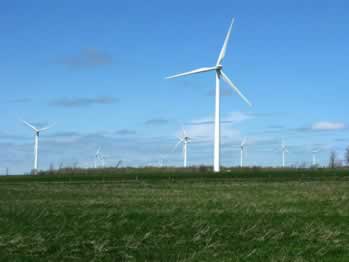 Berkeley Lab Study Finds No Widespread Impact of Wind Power Projects on Surrounding Residential Property Values in the U.S.Dec 2, 2009 - Berkeley Lab Media contact: Allan Chen (510) 486-4210, a_chen@lbl.gov
|
| Home sales prices are very sensitive to the overall quality of the scenic vista from a property, but a view of a wind energy facility does not demonstrably impact sales prices. |
Over 30,000 megawatts of wind energy capacity are installed across the United States and an increasing number of communities are considering new wind power facilities. Given these developments, there is an urgent need to empirically investigate typical community concerns about wind energy and thereby provide stakeholders involved in the wind project siting process a common base of knowledge. A major new report released today by the U.S. Department of Energy’s (DOE) Lawrence Berkeley National Laboratory evaluates one of those concerns, and finds that proximity to wind energy facilities does not have a pervasive or widespread adverse effect on the property values of nearby homes.
 The new report, funded by the DOE, is based on site visits, data collection, and analysis of almost 7,500 single-family home sales, making it the most comprehensive and data-rich analysis to date on the potential impact of U.S. wind projects on residential property values.
The new report, funded by the DOE, is based on site visits, data collection, and analysis of almost 7,500 single-family home sales, making it the most comprehensive and data-rich analysis to date on the potential impact of U.S. wind projects on residential property values.
“Neither the view of wind energy facilities nor the distance of the home to those facilities was found to have any consistent, measurable, and significant effect on the selling prices of nearby homes,” says report author Ben Hoen, a consultant to Berkeley Lab. “No matter how we looked at the data, the same result kept coming back - no evidence of widespread impacts.”
The team of researchers for the project collected data on homes situated within 10 miles of 24 existing wind facilities in nine different U.S. states; the closest home was 800 feet from a wind facility. Each home in the sample was visited to collect important on-site information such as whether wind turbines were visible from the home. The home sales used in the study occurred between 1996 and 2007, spanning the period prior to the announcement of each wind energy facility to well after its construction and full-scale operation.
The conclusions of the study are drawn from eight different hedonic pricing models, as well as repeat sales and sales volume models. A hedonic model is a statistical analysis method used to estimate the impact of house characteristics on sales prices. None of the models uncovered conclusive statistical evidence of the existence of any widespread property value effects that might be present in communities surrounding wind energy facilities.
“It took three years to collect all of the data and analyze more than 50 different statistical model specifications,” says co-author and project manager Ryan Wiser of Berkeley Lab, “but without that amount of effort, we would not have been confident we were giving stakeholders the best information possible.”
“Though the analysis cannot dismiss the possibility that individual homes or small numbers of homes have been negatively impacted, it finds that if these impacts do exist, their frequency is too small to result in any widespread, statistically observable impact,” he added.
The analysis revealed that home sales prices are very sensitive to the overall quality of the scenic vista from a property, but that a view of a wind energy facility did not demonstrably impact sales prices. The Berkeley Lab researchers also did not find statistically observable differences in prices for homes located closer to wind facilities than those located further away, or for homes that sold after the announcement or construction of a wind energy facility when compared to those selling prior to announcement. Even for those homes located within a one-mile distance of a wind project, the researchers found no persuasive evidence of a property value impact.
“Although studies that have investigated residential sales prices near conventional power plants, high voltage transmission lines, and roads have found some property value impacts,” says co-author and San Diego State University Economics Department Chair Mark Thayer, “the same cannot be said for wind energy facilities, at least given our sample of transactions.“
Berkeley Lab is a DOE national laboratory located in Berkeley, California. It conducts unclassified scientific research for DOE’s Office of Science and is managed by the University of California. Visit our Website at www.lbl.gov/
Additional Information:
- Download the report, “The Impact of Wind Power Projects on Residential Property Values in the United States: A Multi-Site Hedonic Analysis”
- View a PowerPoint presentation summarizing key findings from the study
- More information about DOE’s Wind and Hydropower Technologies Program
- For more information on the report, contact Ben Hoen (benhoen2@earthlink.net, 845-758-1896) or Ryan Wiser (RHWiser@lbl.gov, 510-486-5474).
Email this page to a friend
If you speak another language fluently and you liked this page, make
a contribution by translating
it! For additional translations check out FreeTranslation.com
(Voor vertaling van Engels tot Nederlands)
(For oversettelse fra Engelsk til Norsk)
(Для дополнительных
переводов проверяют
FreeTranslation.com )

